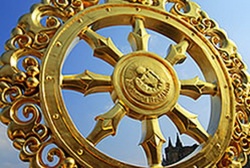Three calamities
three calamities
三災 (Jpn san-sai )
Disasters said to occur at the end of a kalpa. There are two sets of three calamities, lesser and greater.
(1) The three lesser calamities are warfare, pestilence, and famine. The calamity of famine is also called the calamity of high grain prices or inflation, because inflation was caused by a shortage of grain. These calamities are said to occur at the end of each kalpa of decrease in the kalpa of continuance. According to one explanation, all three occur at the end of each kalpa of decrease; first, war rages for seven days, then epidemics prevail for seven months, and finally famine lasts for seven years. According to another, they occur alternately, pestilence at the end of the first kalpa of decrease, war at the end of the second, famine at the end of the third, and so on, each calamity lasting for seven days. In a 1279 letter titled King Rinda, Nichiren described the cause of the three lesser calamities as the three poisons of greed, anger, and foolishness, the fundamental evils inherent in life, stating that greed brings about famine, anger incites war, and foolishness leads to pestilence.
(2) The three greater calamities are fire, water, and wind. These are said to occur at the end of the kalpa of decline following the kalpa of continuance and to destroy the world. In the calamity of fire, seven suns appear at the same time and burn up the world. The flames reach from the hell of incessant suffering to the first meditation heaven in the world of form. In the calamity of water, flood sweeps away everything from the hell of incessant suffering up through the second meditation heaven. In the calamity of wind, a great storm demolishes everything from the hell of incessant suffering up through the third meditation heaven.
